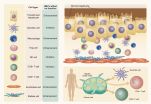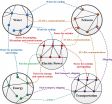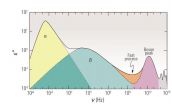(Press-News.org) Planets orbiting close to low-mass stars -- easily the most common stars in the universe -- are prime targets in the search for extraterrestrial life.
But new research led by an astronomy graduate student at the University of Washington indicates some such planets may have long since lost their chance at hosting life because of intense heat during their formative years.
Low-mass stars, also called M dwarfs, are smaller than the Sun, and also much less luminous, so their habitable zone tends to be fairly close in. The habitable zone is that swath of space that is just right to allow liquid water on an orbiting planet's surface, thus giving life a chance.
Planets close to their host stars are easier for astronomers to find than their siblings farther out. Astronomers discover and measure these worlds by studying the slight reduction in light when they transit, or pass in front of their host star; or by measuring the star's slight "wobble" in response to the planet's gravity, called the radial velocity method.
But in a paper to be published in the journal Astrobiology, doctoral student Rodrigo Luger and co-author Rory Barnes, a UW research assistant professor, find through computer simulations that some planets close to low-mass stars likely had their water and atmospheres burned away when they were still forming.
"All stars form in the collapse of a giant cloud of interstellar gas, which releases energy in the form of light as it shrinks," Luger said. "But because of their lower masses, and therefore lower gravities, M dwarfs take longer to fully collapse -- on the order of many hundreds of millions of years."
"Planets around these stars can form within 10 million years, so they are around when the stars are still extremely bright. And that's not good for habitability, since these planets are going to initially be very hot, with surface temperatures in excess of a thousand degrees. When this happens, your oceans boil and your entire atmosphere becomes steam."
Also boding ill for the atmospheres of these worlds is the fact that M dwarf stars emit a lot of X-ray and ultraviolet light, which heats the upper atmosphere to thousands of degrees and causes gas to expand so quickly it leaves the planet and is lost to space, Luger said.
"So, many of the planets in the habitable zones of M dwarfs could have been dried up by this process early on, severely decreasing their chance of actually being habitable."
A side effect of this process, Luger and Barnes write, is that ultraviolet radiation can split up water into its component hydrogen and oxygen atoms. The lighter hydrogen escapes the atmosphere more easily, leaving the heavier oxygen atoms behind. While some oxygen is clearly good for life, as on Earth, too much oxygen can be a negative factor for the origin of life.
"Rodrigo has shown that this prolonged runaway greenhouse phase can produce huge atmospheres full of oxygen -- like, 10 times denser than that of Venus and all oxygen," said Barnes. "Searches for life often rely on oxygen as a tracer of extraterrestrial life -- so the abiological production of such huge quantities of oxygen could confound our search for life on exoplanets."
Luger said the working title of their paper was "Mirage Earths."
"Because of the oxygen they build up, they could look a lot like Earth from afar -- but if you look more closely you'll find that they're really a mirage; there's just no water there."
INFORMATION:
For more information, contact Luger at 206-543-6276 or rodluger@gmail.com; or Barnes at 206-543-8979 or rory@astro.washington.edu.
People in the country's unhappiest communities spend about a quarter of the month so far down in the dumps that it can harm their productivity, according to economists.
"This is a real concern not just in the United States, but across the world," said Stephan Goetz, professor of agricultural economics and regional economics, Penn State, and director of the Northeast Regional Center for Rural Development. "Poor mental health can result in considerable economic costs, including losses of billions of dollars to lower productivity and this doesn't even include the staggering ...
PHILADELPHIA--Quitting smoking sets off a series of changes in the brain that Penn Medicine researchers say may better identify smokers who will start smoking again--a prediction that goes above and beyond today's clinical or behavioral tools for assessing relapse risk.
Reporting in a new study published this week in the journal Neuropsychopharmacology, James Loughead, PhD, associate professor of Psychiatry, and Caryn Lerman, PhD, a professor of Psychiatry and director of Penn's Center for Interdisciplinary Research on Nicotine Addiction, found that smokers who relapsed ...
Recent research from the Met Office and the University of East Anglia (UEA) suggests breaking the existing global and UK temperature records is much more likely due to human influence on the climate.
Early Figures Suggest Global Record Possible
The global mean temperature for January to October based on the HadCRUT4 dataset (compiled by the Met Office and UEA's Climatic Research Unit) is 0.57 °C (+/- 0.1) above the long-term (1961-1990) average. This is consistent with the statement from the World Meteorological Organization (WMO) today.
With two months of data still ...
Researchers at the Mechanobiology Institute at the National University of Singapore have comprehensively described the network of proteins involved in cell-cell adhesions, or the cadherin interactome. This work was published in Science Signaling (Guo et al. E-cadherin interactome complexity and robustness resolved by quantitative proteomics, Science Signaling, 02 Dec 2014, Vol 7, Issue 354).
Unlocking the complexity of cell adhesion
Many biological processes depend on the ability of cells to stick to one another. The formation of multicellular organisms and precise ...
Plastic is well-known for sticking around in the environment for years without breaking down, contributing significantly to litter and landfills. But scientists have now discovered that bacteria from the guts of a worm known to munch on food packaging can degrade polyethylene, the most common plastic. Reported in the ACS journal Environmental Science & Technology, the finding could lead to new ways to help get rid of the otherwise persistent waste, the scientists say.
Jun Yang and colleagues point out that the global plastics industry churns out about 140 million tons ...
Hepatocellular carcinoma (HCC) is one of the few cancers in which a continued increase in incidence has been observed over recent years. Globally, there are approximately 750,000 new cases of liver cancer reported each year. Importantly, population-based studies show that HCC ranks as the third leading cause of cancer-related deaths worldwide. Also, a large proportion of HCC patients display symptoms of intrahepatic metastases or postsurgical recurrence, with a five-year survival rate of around only 30-40%.
Among the various pathogenic factors, HBV infection accounts ...
Current asthma treatments can alleviate wheezing, coughing and other symptoms felt by millions of Americans every year, but they don't get to the root cause of the condition. Now, for the first time, scientists are reporting a new approach to defeating asthma by targeting the trigger -- the allergen -- before it can spark an attack. They describe their new compound, which they tested on rats, in ACS' Journal of Medicinal Chemistry.
Clive Robinson and colleagues explain that to prevent many health problems, the ideal approach to treatment or prevention involves getting ...
The interdisciplinary field of network science has attracted enormous attention in the past 10 years, although most results have been obtained by analyzing isolated networks. However many real-world networks interact with and depend on other networks.
"The properties and dynamics of interdependent and interconnected networks have been studied extensively, and scientists are finding many interesting results and discovering many surprising phenomena," state scientists based in China, the US and Israel who co-authored a new study, "From a single network to a network of ...
Humans have been experimenting with and utilizing glassy materials for more than ten millennia, dating back to about 12000 B.C. Although glassy materials are the oldest known artificial materials, new discoveries and novel applications continue to appear.
Yet understanding of glass is far from complete, and the nature of glass constitutes a longstanding puzzle in condensed mater physics.
In a new overview titled "The β-Relaxation in Metallic Glasses" and published in the Beijing-based National Science Review, co-authors Hai Bin Yu and and Konrad Samwer, based at ...
In order to observe the impact of climate change on soil microorganisms under as natural conditions as possible, the scientists transferred intact young beech seedlings from a cool, wet, northwest-exposed site of a slope approximately corresponding to present climatic conditions to a warmer site exposed to the southwest. This transfer simulated temperature and precipitation profiles as can be expected from climate change. "We tried to keep initial soil type and nutrient content sin soil as comparable as possible to avoid additional factors influencing our data"," said Prof. ...




